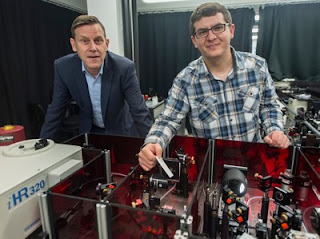It is a long-cherished dream: Removing the inert greenhouse gas carbon dioxide from the atmosphere and using it as a basic material for the chemical industry. This could address two major problems at once by containing climate change and at the same time reducing the dependence on oil. Physico-chemists at the University of Bonn are in the process of making significant contributions to this vision. They have discovered a new way to create a highly reactive form of carbon dioxide with the help of laser pulses. The results have been published online in advance and will soon be presented in the printed edition of the journal "Angewandte Chemie."
Every day, nature shows humans how to elegantly bind carbon dioxide from the air and transform it into a much-needed raw material. Plants perform photosynthesis with their green leaves when exposed to light. Oxygen and the much-needed energy and nutrient supplier sugar are created from carbon dioxide and water with the help of sunlight.
"Scientists have been striving to mimic this model for a long time, for instance in order to use carbon dioxide for the chemical industry," says Prof. Dr. Peter Vöhringer from the Institute for Physical and Theoretical Chemistry of the University of Bonn. What makes the concept hard to implement is that it is very difficult to push carbon dioxide into new partnerships with other molecules.
With his team, the physico-chemist has now discovered a new way of generating a highly reactive variant of the inert and hard-to-bind greenhouse gas. The researchers used a so-called iron complex: The center contains a positively charged iron atom, to which the constituents of the carbon dioxide are already bound multiple times. The scientists shot ultrashort laser pulses of ultraviolet light onto this iron complex, which broke certain bonds. The resulting product was a so-called carbon dioxide radical, which also forms new bonds with a certain radicality.
Such radicals have a single electron in their outer shell that urgently wants to bind permanently to another molecule or atom. "It is this unpaired electron that distinguishes our reactive radical anion bound to the central iron atom from the inert carbon dioxide and makes it so promising for chemical processes," explains lead author Steffen Straub from Vöhringer's team. The radicals could in turn be the building blocks for interesting chemical products, such as methanol as a fuel or urea for chemical syntheses and salicylic acid as a pain medication.
Read more at Ultrashort Laser Pulses Make Greenhouse Gas Reactive

No comments:
Post a Comment